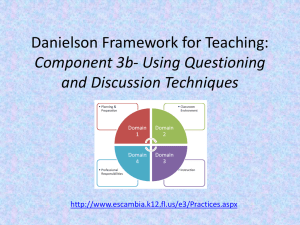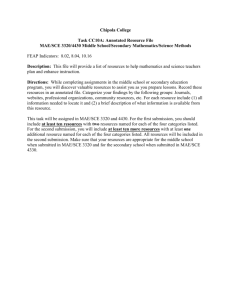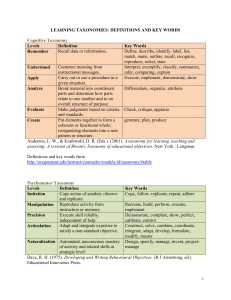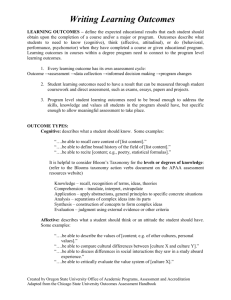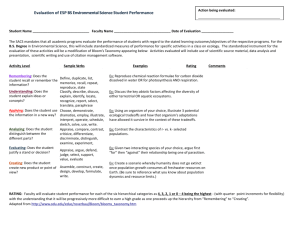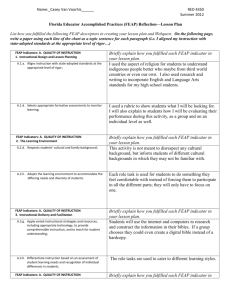Critical Thinking - Assessment System Product
advertisement
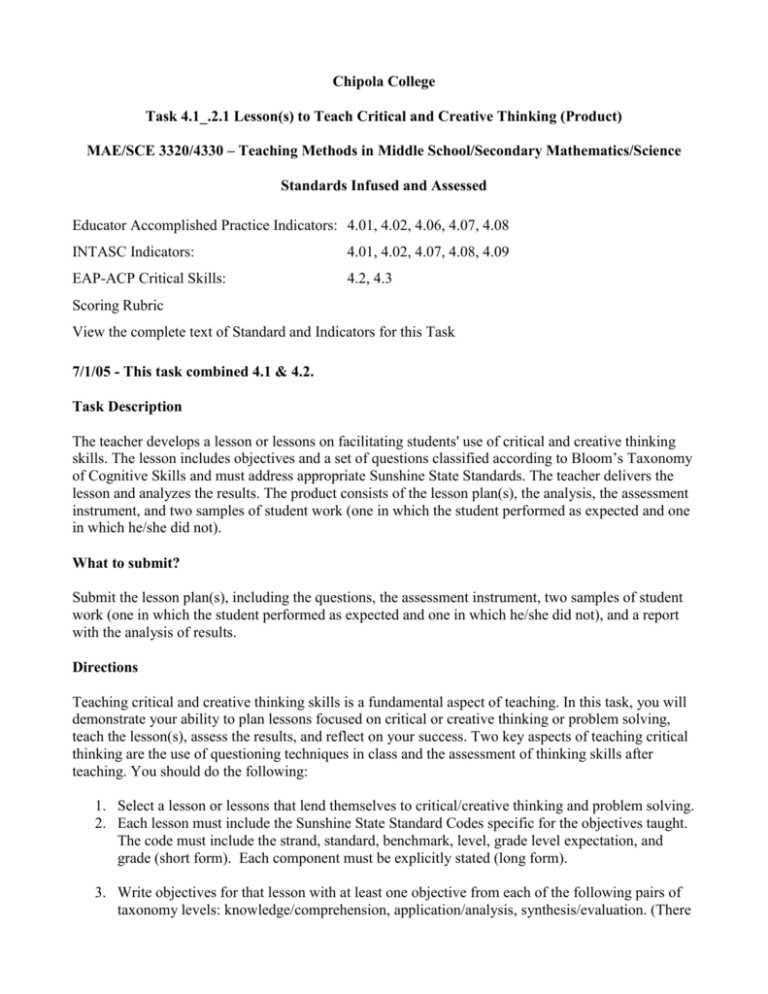
Chipola College Task 4.1_.2.1 Lesson(s) to Teach Critical and Creative Thinking (Product) MAE/SCE 3320/4330 – Teaching Methods in Middle School/Secondary Mathematics/Science Standards Infused and Assessed Educator Accomplished Practice Indicators: 4.01, 4.02, 4.06, 4.07, 4.08 INTASC Indicators: 4.01, 4.02, 4.07, 4.08, 4.09 EAP-ACP Critical Skills: 4.2, 4.3 Scoring Rubric View the complete text of Standard and Indicators for this Task 7/1/05 - This task combined 4.1 & 4.2. Task Description The teacher develops a lesson or lessons on facilitating students' use of critical and creative thinking skills. The lesson includes objectives and a set of questions classified according to Bloom’s Taxonomy of Cognitive Skills and must address appropriate Sunshine State Standards. The teacher delivers the lesson and analyzes the results. The product consists of the lesson plan(s), the analysis, the assessment instrument, and two samples of student work (one in which the student performed as expected and one in which he/she did not). What to submit? Submit the lesson plan(s), including the questions, the assessment instrument, two samples of student work (one in which the student performed as expected and one in which he/she did not), and a report with the analysis of results. Directions Teaching critical and creative thinking skills is a fundamental aspect of teaching. In this task, you will demonstrate your ability to plan lessons focused on critical or creative thinking or problem solving, teach the lesson(s), assess the results, and reflect on your success. Two key aspects of teaching critical thinking are the use of questioning techniques in class and the assessment of thinking skills after teaching. You should do the following: 1. Select a lesson or lessons that lend themselves to critical/creative thinking and problem solving. 2. Each lesson must include the Sunshine State Standard Codes specific for the objectives taught. The code must include the strand, standard, benchmark, level, grade level expectation, and grade (short form). Each component must be explicitly stated (long form). 3. Write objectives for that lesson with at least one objective from each of the following pairs of taxonomy levels: knowledge/comprehension, application/analysis, synthesis/evaluation. (There should be more than three objectives, though.) 4. Classify the objectives in the lessons according to Bloom's cognitive taxonomy; another theory of thinking skills (e.g., Torrance, De Bono, Guilford, Gardner, or Williams); or a planning guide for instruction specifically designed for creativity, higher-order, or critical thinking skills. 5. Incorporate specific instructional activities in which you can model or demonstrate the skills you want your students to learn and demonstrate. 6. Include at least two questioning activities that would demonstrate learning for each objective. You may pose problems, dilemmas, questions, or you may use other strategies in the lessons to fulfill this requirement. 7. Conduct the planned instruction, using the questioning activities. 8. Include the materials and assessments and any activities to be used. 9. Conduct a post-assessment of the skills you were trying to teach. This assessment could be either a traditional test or an alternative assessment. 10. After teaching and assessing the lesson(s), write an analysis of how the students responded to the questions and the extent to which students were able to exhibit their ability to think critically and creatively and to solve problems. Include the following in your analysis: o A narrative discussion of what happened during the lesson(s), including how you modeled the skills and what your students did o An analysis of how the students responded to your questions at the level of creative/critical thinking planned o A description of how you modified and adjusted your strategies during delivery o An analysis of the assessment results o Discussion of how you would modify the lesson the next time it is delivered 01/25/05 © Copyright 2002, Florida Department of Education Task 4.1_2.1: Lesson(s) to Teach Critical and Creative Thinking Name: _____________ Submission #: ____ FEAP 4.01: Provides opportunities for students to learn higher-order thinking skills. FEAP 4.02: Identifies strategies, materials, and technologies which she/he will use to expand students’ thinking abilities. FEAP 4.06: Varies her/his role in the instructional process (instructor, coach, mentor, facilitator, audience, critic, etc.) in relation to the purposes of instruction and the students’ needs, including linguistic needs. FEAP 4.07: Demonstrates and models the use of higher-order thinking abilities. FEAP 4.08: Modifies and adapts lessons with increased attention to the learners’ creative thinking abilities. Decision for E.A.P. on this Task (check one): Demonstrated: 8 or more ratings are acceptable; none are unacceptable. Partially Demonstrated: 5 to 12 ratings are marginal; none are unacceptable. Not Demonstrated: 1 or more ratings are unacceptable. Rating Scale Key: A = acceptable; M = marginal; U = unacceptable Element # Criteria for "acceptable" rating Rating Plan 1 There is at least one objective for each pair of levels in Bloom's taxonomy, and it is classified correctly according to Bloom's taxonomy. __ A __ M __ U 2 Each lesson includes the appropriate Sunshine State Standard Codes specific for the objectives taught. This code includes the strand, standard, benchmark, level, grade __ A __ M __ U level expectation, and grade (short form). Each component must be explicitly stated (long form). 3 There are at least two questions or questioning activities for each objective. __ A __ M __ U 4 Activities, strategies, materials, and/or technologies provide students the opportunity to expand their thinking skills. __ A __ M __ U 5 Instructional strategies provide for teacher modeling of the __ A __ M __ U skills to be learned. 6 The plan indicates that the teacher understands the cognitive processes associated with various kinds of learning and how these processes can be stimulated. __ A __ M __ U 6 Assessment(s) provide students the opportunity to demonstrate the use of higher order thinking. __ A __ M __ U 7 Assessment(s) measure the higher order skills to be acquired. __ A __ M __ U 8 The teacher has provided opportunities for students to learn higher-order thinking skills. __ A __ M __ U 9 The teacher accurately includes all Sunshine State Standards in both short and long form. __ A __ M __ U 10 The teacher has correctly analyzed the level of performance of the students on Bloom's taxonomy. __ A __ M __ U 11 The teacher describes modifications made during instruction, and they are appropriate. __ A __ M __ U 12 The follow-up plan for subsequent learning is appropriate. __ A __ M __ U 13 The teacher describes modifications suggested for future instruction, and they are appropriate. __ A __ M __ U Assessment Analysis/Report Improvements Needed: Comments: 01/25/05 © Copyright 2002, Florida Department of Education



